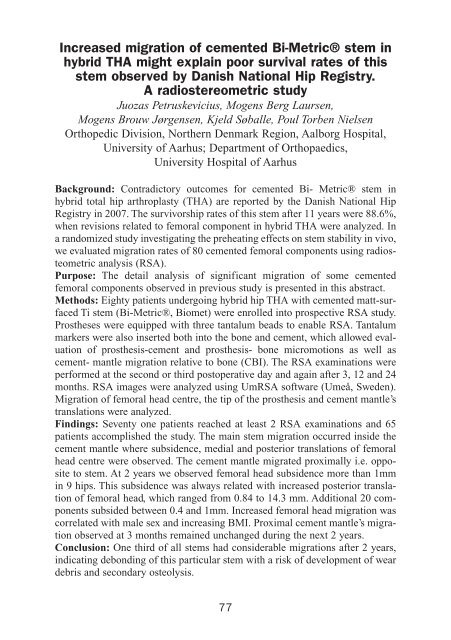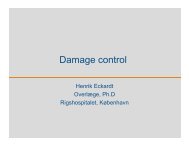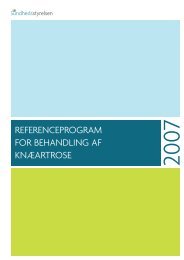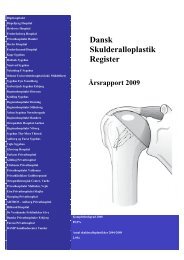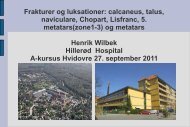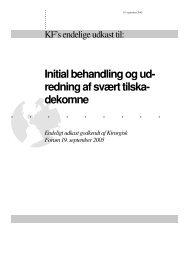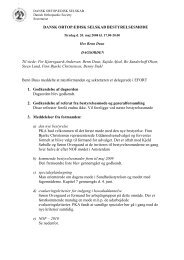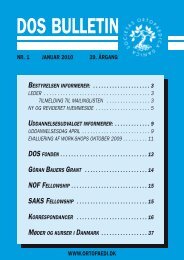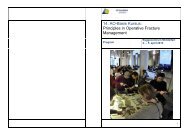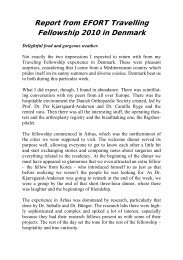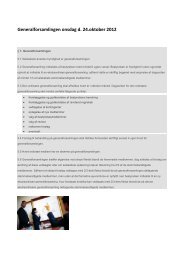DOS BULLETIN - Dansk Ortopædisk Selskab
DOS BULLETIN - Dansk Ortopædisk Selskab
DOS BULLETIN - Dansk Ortopædisk Selskab
You also want an ePaper? Increase the reach of your titles
YUMPU automatically turns print PDFs into web optimized ePapers that Google loves.
2010-378_<strong>DOS</strong> nr. 3 2010 29/09/10 10:08 Side 77<br />
Increased migration of cemented Bi-Metric® stem in<br />
hybrid THA might explain poor survival rates of this<br />
stem observed by Danish National Hip Registry.<br />
A radiostereometric study<br />
Juozas Petruskevicius, Mogens Berg Laursen,<br />
Mogens Brouw Jørgensen, Kjeld Søballe, Poul Torben Nielsen<br />
Orthopedic Division, Northern Denmark Region, Aalborg Hospital,<br />
University of Aarhus; Department of Orthopaedics,<br />
University Hospital of Aarhus<br />
Background: Contradictory outcomes for cemented Bi- Metric® stem in<br />
hybrid total hip arthroplasty (THA) are reported by the Danish National Hip<br />
Registry in 2007. The survivorship rates of this stem after 11 years were 88.6%,<br />
when revisions related to femoral component in hybrid THA were analyzed. In<br />
a randomized study investigating the preheating effects on stem stability in vivo,<br />
we evaluated migration rates of 80 cemented femoral components using radiosteometric<br />
analysis (RSA).<br />
Purpose: The detail analysis of significant migration of some cemented<br />
femoral components observed in previous study is presented in this abstract.<br />
Methods: Eighty patients undergoing hybrid hip THA with cemented matt-surfaced<br />
Ti stem (Bi-Metric®, Biomet) were enrolled into prospective RSA study.<br />
Prostheses were equipped with three tantalum beads to enable RSA. Tantalum<br />
markers were also inserted both into the bone and cement, which allowed evaluation<br />
of prosthesis-cement and prosthesis- bone micromotions as well as<br />
cement- mantle migration relative to bone (CBI). The RSA examinations were<br />
performed at the second or third postoperative day and again after 3, 12 and 24<br />
months. RSA images were analyzed using UmRSA software (Umeå, Sweden).<br />
Migration of femoral head centre, the tip of the prosthesis and cement mantle’s<br />
translations were analyzed.<br />
Findings: Seventy one patients reached at least 2 RSA examinations and 65<br />
patients accomplished the study. The main stem migration occurred inside the<br />
cement mantle where subsidence, medial and posterior translations of femoral<br />
head centre were observed. The cement mantle migrated proximally i.e. opposite<br />
to stem. At 2 years we observed femoral head subsidence more than 1mm<br />
in 9 hips. This subsidence was always related with increased posterior translation<br />
of femoral head, which ranged from 0.84 to 14.3 mm. Additional 20 components<br />
subsided between 0.4 and 1mm. Increased femoral head migration was<br />
correlated with male sex and increasing BMI. Proximal cement mantle’s migration<br />
observed at 3 months remained unchanged during the next 2 years.<br />
Conclusion: One third of all stems had considerable migrations after 2 years,<br />
indicating debonding of this particular stem with a risk of development of wear<br />
debris and secondary osteolysis.<br />
77


